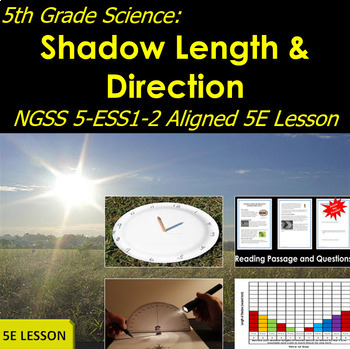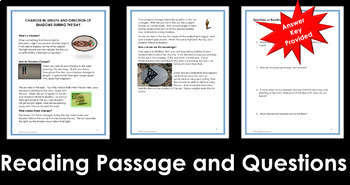5th Grade Science: Shadow Length and Direction NGSS 5-ESS1-2 Aligned Lesson
- Zip
What educators are saying
Also included in
- These units are especially designed for teachers using NGSS. These are phenomena-based lessons that are in 5E format. Units cover Matter and Its Interactions, Gravity, Photosynthesis, Energy, Ecosystems, Earth’s Place in the Universe, Earth Systems, and Earth and Human Activity. Be sure to checkPrice $91.08Original Price $113.85Save $22.77
- NGSS 5-ESS1-1 and NGSS 5-ESS1-2 5E Lesson Plans are included in this Bundle. These lessons plans are designed to be fun and engaging for your students.Product Descriptions NGSS 5-ESS1-1 Brightness of the Sun and Stars – Support an argument that differences in the apparent brightness of the sun compPrice $12.20Original Price $15.25Save $3.05
Description
5th Grade Science: Shadow Length and Direction NGSS 5-ESS1-2 Aligned Lesson
You don't have to go outside to teach about shadows. With PowerPoint presentations, a video, hands-on lab exercises, and an explanatory reading passage, students will discover how shadows change in direction and size during the day in their classroom.
This Project provides two instructional PowerPoint presentations to set up and perform this experiment. Teachers will only need to duplicate forms and supply scissors, glue sticks, and flashlights to groups. We recommend three students to a group but larger or smaller groups will be fine. This Lab can be done in the classroom with no need to go outside.
This unit is for 5th grade NGSS Performance Expectation 5-ESS1-2.
Represent data in graphical displays to reveal patterns of daily changes in length and direction of shadows, day and night, and the seasonal appearance of some stars in the night sky. Note: This lesson focuses only on change in shadows, length and direction
This unit also covers the NGSS Science and Engineering Processes of :
• Analyzing and Interpreting Data
This lesson uses the 5E Lesson Plan process
The 5E steps are:
Engage: Students watch a PowerPoint presentation with a video link on shadows and the motion of the sun. This presentation is editable in the event the teacher wants to add, delete or change any slides.
Explore: Here students will perform a lab experiment using easily available materials like paper and a flashlight. They make and record measurements, then graph their data and interpret what the data is telling them. Separate record sheets and graph paper are provided for collecting and charting their data.
Explain: Students will first explain and analyze the data they collected and graphed during the lab exercise. The students will then read a passage explaining how shadows are dependent on the position of the sun during the day. The students will also answer questions on the reading. Answer keys are provided.
Elaborate: one elaboration activity on building a working sundial is provided.
Evaluation: In this step, the students must address a situation with a weather predicting groundhog which they must resolve using data and information they have obtained during this lesson. Directions for the essay are included in the Teacher Notes. The students must use evidence to support their statements.
Detailed Teacher notes have been provided to cover all aspects of this unit and the Essay instructions.
What you will get in this Package:
An introduction PowerPoint (Editable) and an engaging introduction video
A lab exercise to produce, record and graph data. Record Sheet and Graph paper is also provided
Detailed instructions to prepare the experimental set-up
A reading that meets science literacy requirements, including questions on the reading and an answer key.
An evaluation assignment which requires the students to refer back to the information they learned during the lesson
Detailed instructions for every step in the 5E process
This Product also supports the following Common Core Standards:
Mathematics
MP.2 – Reason abstractly and quantitatively.
MP.4 – Model with mathematics
5.G.A.2 – Represent real world and mathematical problems by graphing points in the first quadrant of the coordinate plane and interpret coordinate values of points in the context of the situation.
For additional products, please check out our TPT store at:
Note: Next Generation Science Standards is a registered trademark of Achieve. Neither Achieve nor the lead states and partners that developed the Next Generation Science Standards were involved in the production of this product, and do not endorse it.”







